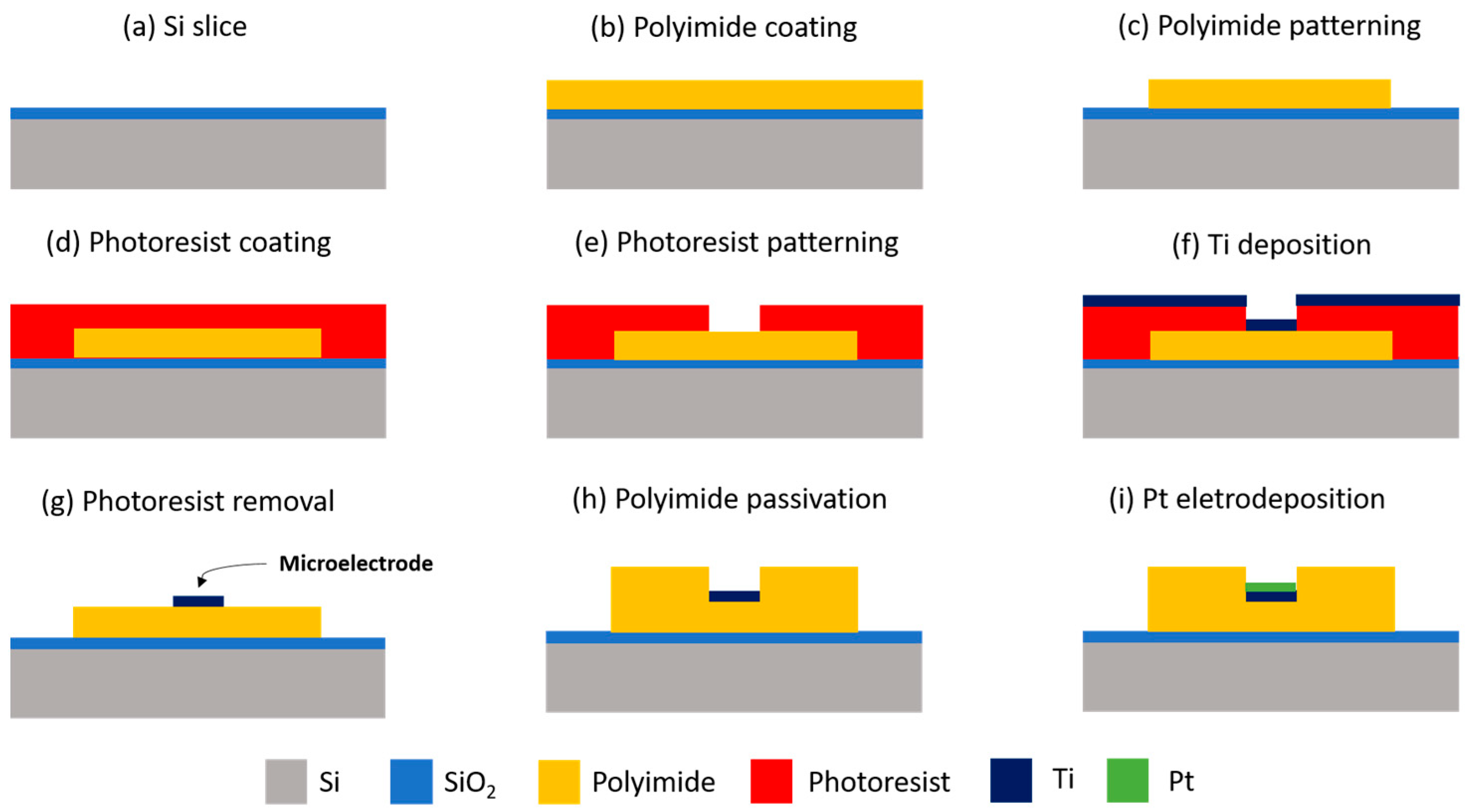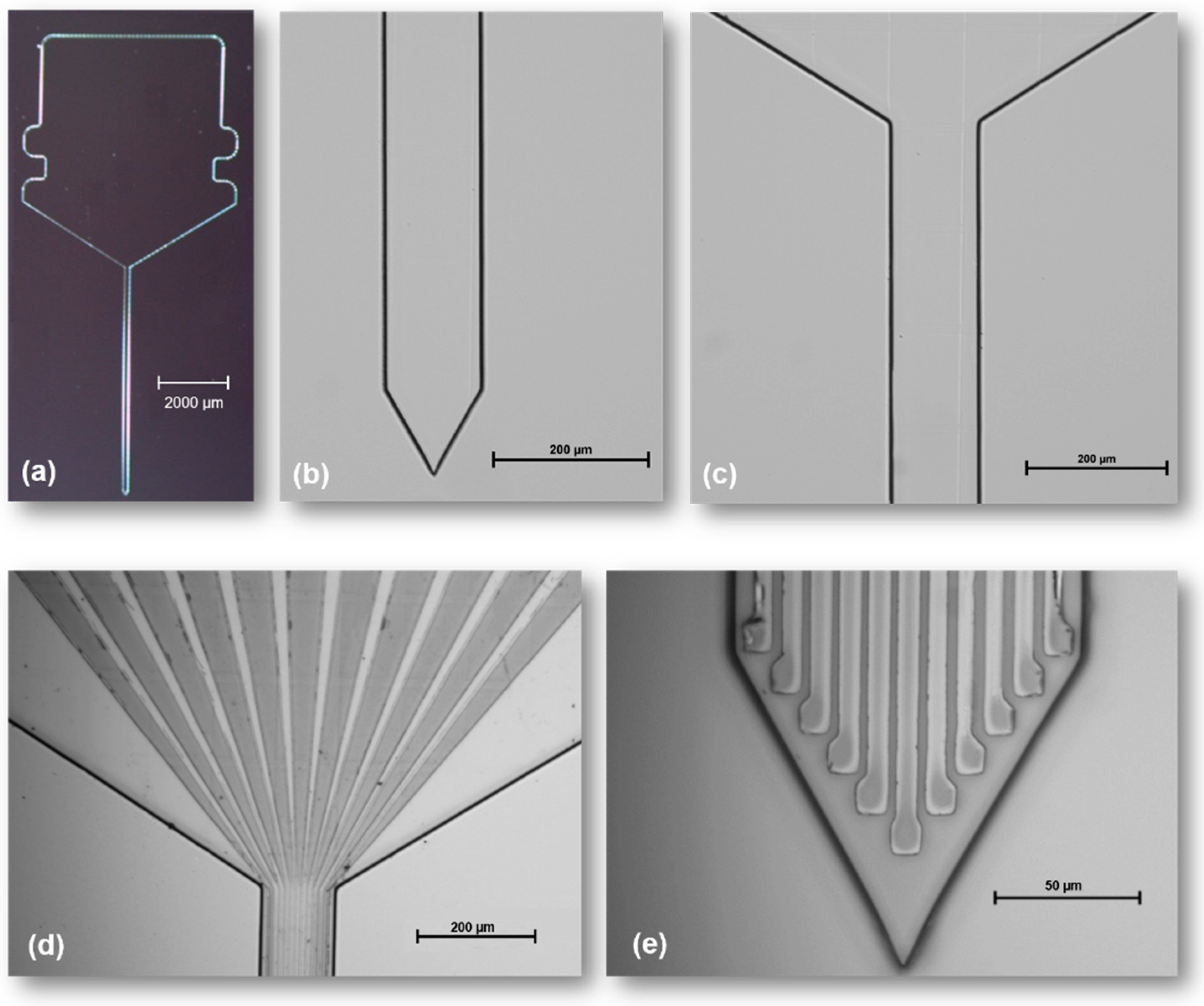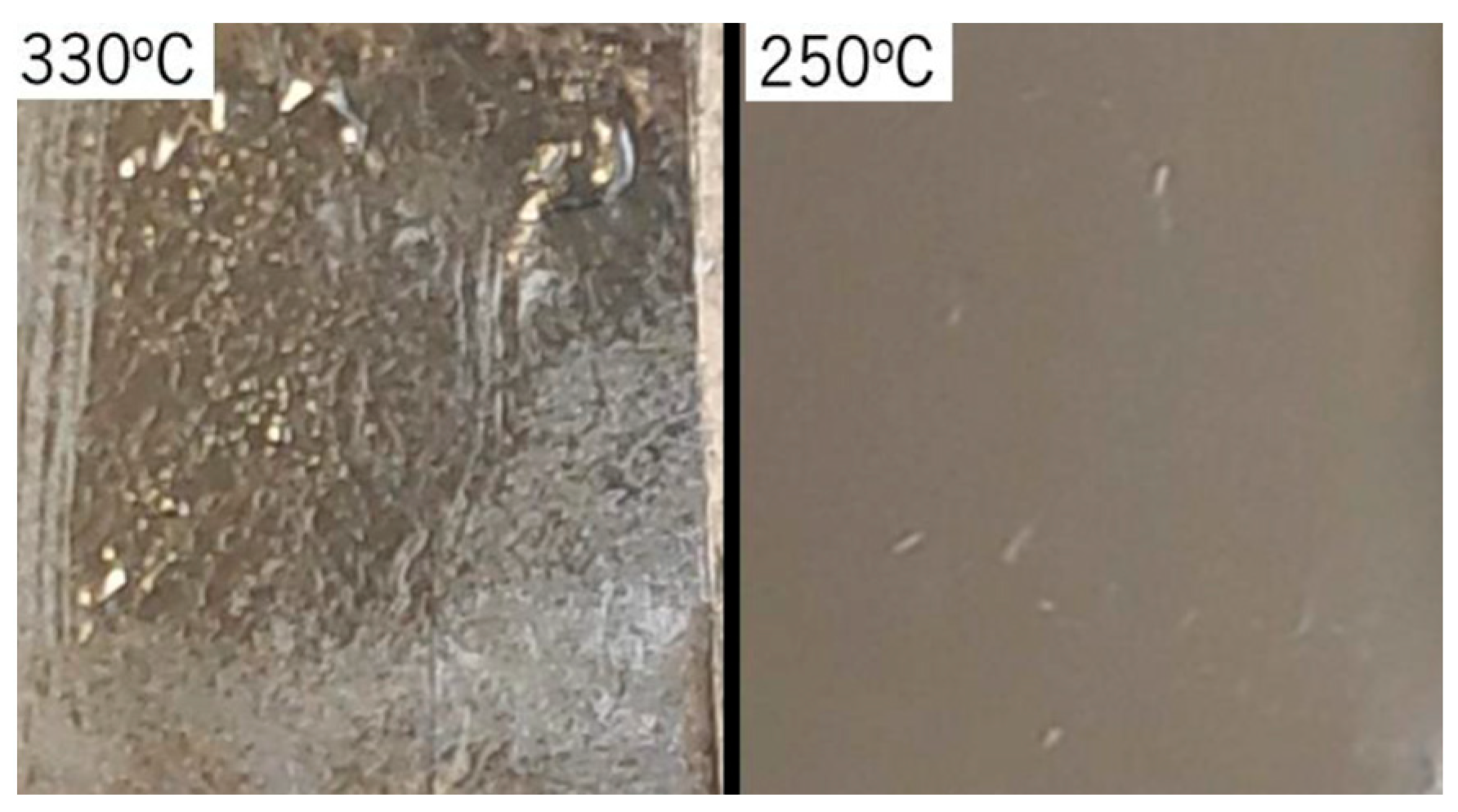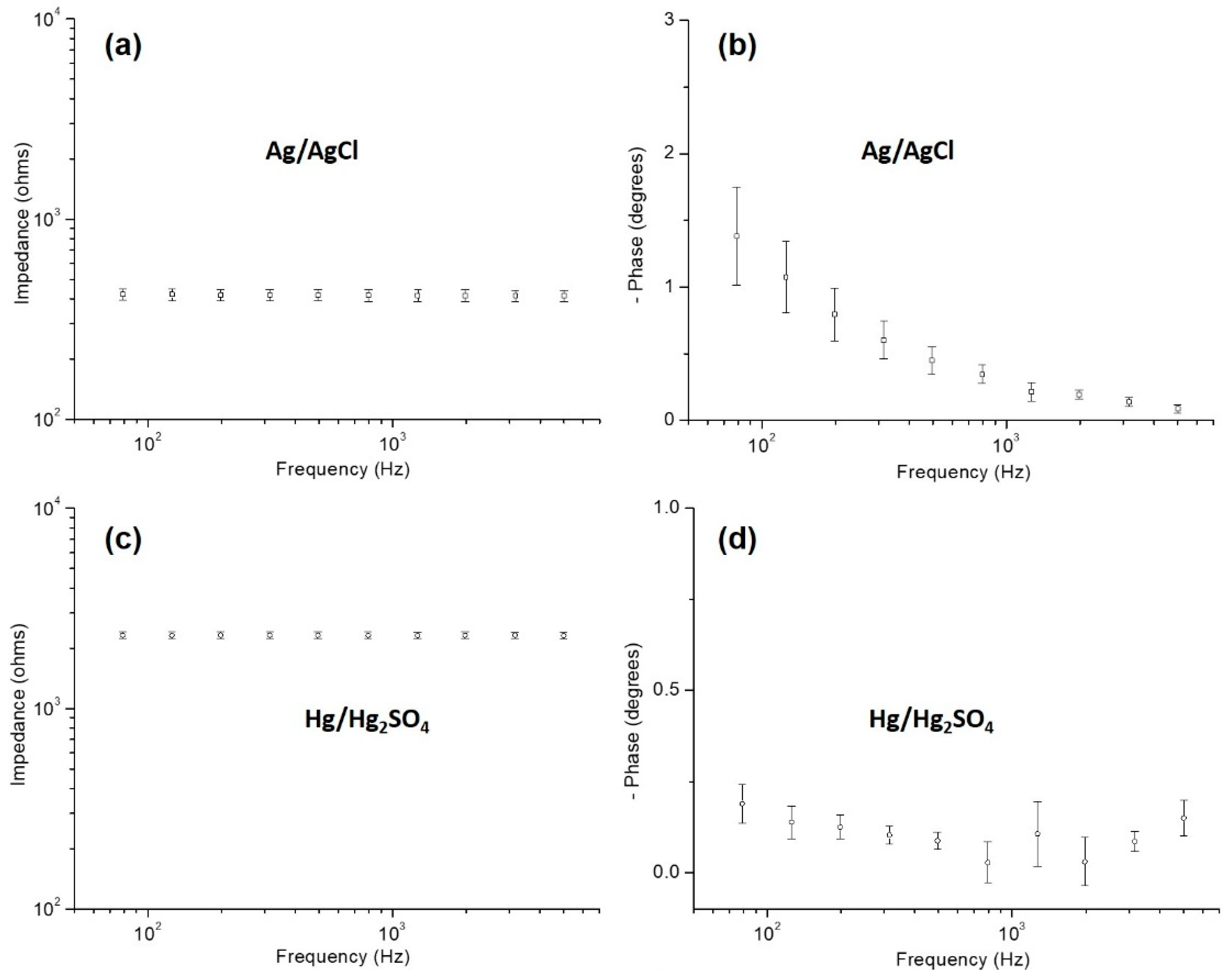Flexible Neural Probe Fabrication Enhanced with a Low-Temperature Cured Polyimide and Platinum Electrodeposition
Abstract
:1. Introduction
2. Materials and Methods
2.1. Microfabrication Process
2.2. Electrochemical Impedance Spectroscopy Measurements
3. Results and Discussion
4. Conclusions
Author Contributions
Funding
Institutional Review Board Statement
Informed Consent Statement
Data Availability Statement
Acknowledgments
Conflicts of Interest
References
- Lecomte, A.; Descamps, E.; Bergaud, C. A Review on Mechanical Considerations for Chronically-Implanted Neural Probes. J. Neural Eng. 2018, 15, 031001. [Google Scholar] [CrossRef] [PubMed]
- Weltman, A.; Yoo, J.; Meng, E. Flexible, Penetrating Brain Probes Enabled by Advances in Polymer Microfabrication. Micromachines 2016, 7, 180. [Google Scholar] [CrossRef] [PubMed] [Green Version]
- Lee, H.C.; Ejserholm, F.; Gaire, J.; Currlin, S.; Schouenborg, J.; Wallman, L.; Bengtsson, M.; Park, K.; Otto, K.J. Histological Evaluation of Flexible Neural Implants; Flexibility Limit for Reducing the Tissue Response? J. Neural Eng. 2017, 14, 036026. [Google Scholar] [CrossRef] [PubMed] [Green Version]
- Pisanello, F. Implantable Micro and Nanophotonic Devices: Toward a New Generation of Neural Interfaces. Microelectron. Eng. 2019, 215, 110979. [Google Scholar] [CrossRef]
- Westerhausen, M.; Martin, T.; Metzger, M.; Blendinger, F.; Fleischer, M.; Hofmann, B.; Bucher, V. Passivated Electrode Side Walls by Atomic Layer Deposition on Flexible Polyimide Based Samples. Microelectron. Eng. 2020, 227, 111315. [Google Scholar] [CrossRef]
- Ahmed, Z.; Reddy, J.W.; Malekoshoaraie, M.H.; Hassanzade, V.; Kimukin, I.; Jain, V.; Chamanzar, M. Flexible Optoelectric Neural Interfaces. Curr. Opin. Biotechnol. 2021, 72, 121–130. [Google Scholar] [CrossRef] [PubMed]
- Pimenta, S.; Rodrigues, J.A.; Machado, F.; Ribeiro, J.F.; Maciel, M.J.; Bondarchuk, O.; Monteiro, P.; Gaspar, J.; Correia, J.H.; Jacinto, L. Double-Layer Flexible Neural Probe With Closely Spaced Electrodes for High-Density in Vivo Brain Recordings. Front. Neurosci. 2021, 15, 663174. [Google Scholar] [CrossRef] [PubMed]
- Xue, X.; Zhou, K.; Cai, J.; Wang, Q.; Wang, Z. Reactive Ion Etching of Poly (Cyclohexene Carbonate) in Oxygen Plasma. Microelectron. Eng. 2018, 191, 1–9. [Google Scholar] [CrossRef]
- Fujifilm Technical Product Information—Durimide 7500; Fujifilm: Tokyo, Japan, 2022.
- Fujifilm Technical Product Information—Low Temperature Cure LTC 9300; Fujifilm: Tokyo, Japan, 2022.
- Stoychev, D.; Papoutsis, A.; Kelaidopoulou, A.; Kokkinidis, G.; Milchev, A. Electrodeposition of Platinum on Metallic and Nonmetallic Substrates—Selection of Experimental Conditions. Mater. Chem. Phys. 2001, 72, 360–365. [Google Scholar] [CrossRef]
- Cogan, S.F. Neural Stimulation and Recording Electrodes. Annu. Rev. Biomed. Eng. 2008, 10, 275–309. [Google Scholar] [CrossRef] [PubMed]
- Instruments, G. Measuring the Impedance of Your Reference Electrode. Available online: https://www.gamry.com/application-notes/instrumentation/measuring-the-impedance-of-your-reference-electrode (accessed on 11 July 2022).
- Schneider, M.; Schroth, S.; Schilm, J.; Michaelis, A. Micro-EIS of Anodic Thin Oxide Films on Titanium for Capacitor Applications. Electrochim. Acta 2009, 54, 2663–2671. [Google Scholar] [CrossRef]
- Wang, S.; Zhang, J.; Gharbi, O.; Vivier, V.; Gao, M.; Orazem, M.E. Electrochemical Impedance Spectroscopy. Nat. Rev. Methods Prim. 2021, 1, 41. [Google Scholar] [CrossRef]
- Lewandowska, M.K.; Bakkum, D.J.; Rompani, S.B.; Hierlemann, A. Recording Large Extracellular Spikes in Microchannels along Many Axonal Sites from Individual Neurons. PLoS ONE 2015, 10, e0118514. [Google Scholar] [CrossRef] [PubMed]
- Fan, B.; Wolfrum, B.; Robinson, J.T. Impedance Scaling for Gold and Platinum Microelectrodes. J. Neural Eng. 2021, 18, 056025. [Google Scholar] [CrossRef] [PubMed]







Publisher’s Note: MDPI stays neutral with regard to jurisdictional claims in published maps and institutional affiliations. |
© 2022 by the authors. Licensee MDPI, Basel, Switzerland. This article is an open access article distributed under the terms and conditions of the Creative Commons Attribution (CC BY) license (https://creativecommons.org/licenses/by/4.0/).
Share and Cite
Freitas, J.R.; Pimenta, S.; Santos, D.J.; Esteves, B.; Gomes, N.M.; Correia, J.H. Flexible Neural Probe Fabrication Enhanced with a Low-Temperature Cured Polyimide and Platinum Electrodeposition. Sensors 2022, 22, 9674. https://doi.org/10.3390/s22249674
Freitas JR, Pimenta S, Santos DJ, Esteves B, Gomes NM, Correia JH. Flexible Neural Probe Fabrication Enhanced with a Low-Temperature Cured Polyimide and Platinum Electrodeposition. Sensors. 2022; 22(24):9674. https://doi.org/10.3390/s22249674
Chicago/Turabian StyleFreitas, João R., Sara Pimenta, Diogo J. Santos, Bruno Esteves, Nuno M. Gomes, and José H. Correia. 2022. "Flexible Neural Probe Fabrication Enhanced with a Low-Temperature Cured Polyimide and Platinum Electrodeposition" Sensors 22, no. 24: 9674. https://doi.org/10.3390/s22249674
APA StyleFreitas, J. R., Pimenta, S., Santos, D. J., Esteves, B., Gomes, N. M., & Correia, J. H. (2022). Flexible Neural Probe Fabrication Enhanced with a Low-Temperature Cured Polyimide and Platinum Electrodeposition. Sensors, 22(24), 9674. https://doi.org/10.3390/s22249674






